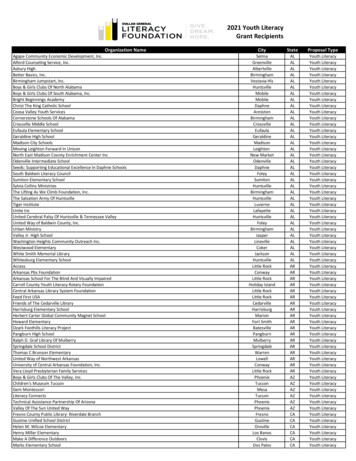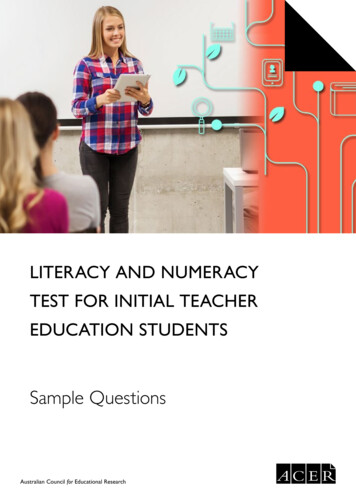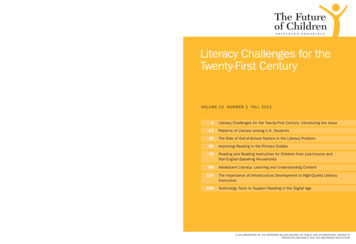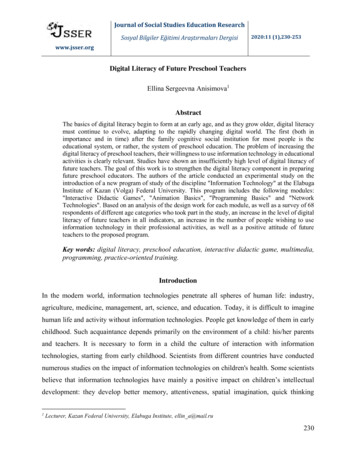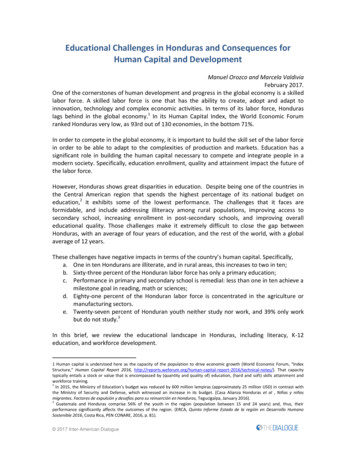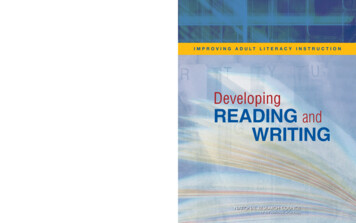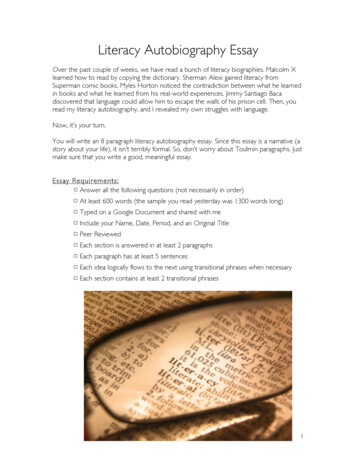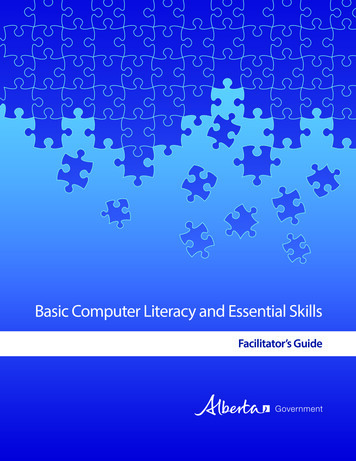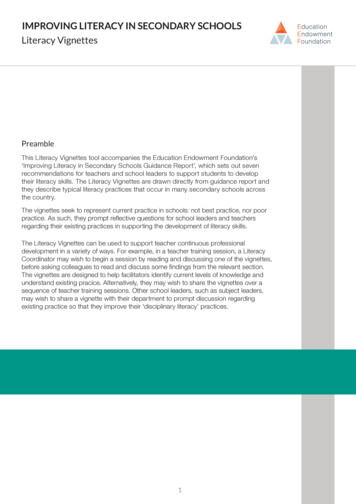
Transcription
IMPROVING LITERACY IN SECONDARY SCHOOLSLiteracy VignettesPreambleThis Literacy Vignettes tool accompanies the Education Endowment Foundation’s‘Improving Literacy in Secondary Schools Guidance Report’, which sets out sevenrecommendations for teachers and school leaders to support students to developtheir literacy skills. The Literacy Vignettes are drawn directly from guidance report andthey describe typical literacy practices that occur in many secondary schools acrossthe country.The vignettes seek to represent current practice in schools: not best practice, nor poorpractice. As such, they prompt reflective questions for school leaders and teachersregarding their existing practices in supporting the development of literacy skills.The Literacy Vignettes can be used to support teacher continuous professionaldevelopment in a variety of ways. For example, in a teacher training session, a LiteracyCoordinator may wish to begin a session by reading and discussing one of the vignettes,before asking colleagues to read and discuss some findings from the relevant section.The vignettes are designed to help facilitators identify current levels of knowledge andunderstand existing pracice. Alternatively, they may wish to share the vignettes over asequence of teacher training sessions. Other school leaders, such as subject leaders,may wish to share a vignette with their department to prompt discussion regardingexisting practice so that they improve their ‘disciplinary literacy’ practices.1
IMPROVING LITERACY IN SECONDARY SCHOOLSLiteracy Vignettes8:40–9:00 Form timeStudents begin form time by taking their reading books from their bags. Most students read teenfiction, though some borrow a non-fiction book from their form’s book box. For fifteen minutes,students read in silence. When the bell rings, books are stowed into bags and they head off totheir lessons.Their form tutor, an experienced science teacher, recognises that reading is intrinsically valuable,but is unsure whether every student is benefiting from this silent reading time. Silent reading is acalm way to start the day and most students seem to enjoy reading, but she is unsure whetherweaker readers use the time well. As a science teacher, she also wonders whether the literacy skillsstudents pick up while reading for pleasure will help them in her subject?Discussion Questions: Does silent reading change students’ attitudes to literacy or improve their outcomes? How transferable are reading skills? For example, is reading fiction likely to help studentsunderstand texts in science? What contribution can non-English teachers make to students’ literacy?9:00–10:00 MathematicsStudents enter the classroom and take out their maths book. They take out their ‘knowledgeorganiser’ for the term, a coloured page which includes key mathematical vocabulary and formulafor the unit of work the class is studying, and begin reading.Following an established routine, students quiz themselves on a section of mathematicalvocabulary, before putting their knowledge organiser to one side and beginning their lesson.Their teacher is pleased that the knowledge organisers distil key knowledge, including importantmathematical terminology. However, she would like to be able to do more to help studentsremember and understand the terms they are trying to learn. For example, she knows thatmathematical terms often have Greek or Latin origins, but is unsure whether explaining this willhelp students.Discussion Questions: How can we ensure that vocabulary instruction is effectively integrated into classroom teaching? How can we move beyond static word lists to support students to develop a deeperunderstanding of the meaning and application of words? How can we ensure that subject specific vocabulary becomes memorable and that students canuse new words in writing and talk?2
IMPROVING LITERACY IN SECONDARY SCHOOLSLiteracy Vignettes10:00–11:00 GeographyNearing the end of the term, the class is a little behind on their GCSE course. The teacher askshis students to read the next four pages of the textbook to explore the ‘challenges of the humanenvironment’, before asking them to make some notes on the chapter.The teacher recognises that some students are struggling with the academic language and thestructure of the textbook, but is unsure how best to address these barriers.He recognises that the complex language of ‘ethnic composition’, ‘net migration’ and ‘socialdeprivation’ is wedded to lots of graphs, images and linked sources, but he is unsure how best toteach students how to ‘read like geographers’ with independence.Discussion Questions: How can we best teach students to read complex informational texts? Which reading strategies improve the accessibility of subject specific texts and genres? How can we support students to become effective independent readers?11:30–12:30 Physical EducationIn Physical Education, the class has been learning about the training plans used by athletespreparing for competitions. As part of this topic, they have been evaluating alternative forms oftraining and analysing which training plans are more likely to be effective in different sports.The teacher wants students to be able to tackle the extended answer questions that call for‘evaluation’ or ‘analysis’ with confidence, but knows that often students struggle with these terms.She thinks that some students are also put off by the length of the answer that is required.To help students, she intends to provide students with a planning sheet and a list of key words thatstrong answers are likely to include. However, she wonders what other types of support she canprovide? Conversely, she wonders whether there a risk of providing too much support?Discussion Questions: How can we break down complex writing tasks? How can we support students to become independent writers? How can we motivate students to persist with challenging writing tasks?3
IMPROVING LITERACY IN SECONDARY SCHOOLSLiteracy Vignettes13:30–14:30 HistoryIn History, students have been studying the Second World War. The class enters the room andsettle, and the teacher begins: ‘OK everyone, we’ve been reading about the Nazi seizure of powerin Germany for three lessons. We know the key ideas. Now it’s time to write.’The teacher has decided to set the students an essay for three main reasons. First, she wantsto assess whether students have understood the ideas and facts they have been learning about.Second, she wants to see whether they are able to express judgements about the relativeimportance of different factors and can support them with evidence. Finally, they will be ultimatelyassessed through writing tasks, so this feels like essential training.She knows some of the class will find the task challenging. Some students can forget keyingredients, such as evidence, or fail to structure their answers clearly, while others struggle to spellunusual words. However, surely this means it’s even more important to practise?Discussion Questions: Where should writing tasks sit within lessons and lesson sequences? How can we integrate reading and writing tasks in different subject areas? How can we support students to improve their spelling, punctuation and grammar?14:30–15:30 Religious StudiesIn Religious Studies, students have been comparing different ethical perspectives on animalexperimentation. Their newly qualified teacher has decided to run the lesson as a debate, andwould like students to prepare and deliver short speeches on the topic.The teacher wants students to be able to participate in academic discussions with confidence andarticulacy. He also knows that discussion has the potential to engage students and extend theirunderstanding of the topic they are studying.However, he is apprehensive, and realises that talk can be unproductive, or become dominated bya small number of students. Another challenge is time. Even when done well, with so much materialto get through in the curriculum, might the debate be a luxury they can’t afford?Discussion Questions: Is it right to view talk as a luxury? How can we structure speaking and listening activities to support learning? Where should discussion activities sit within lessons and lesson sequences?4
IMPROVING LITERACY IN SECONDARY SCHOOLSLiteracy Vignettes15:30 After School SupportAt the end of the day, the head of Year 7 has arranged a catch-up session for a group of studentsthat started the year with low levels of literacy.The head of year knows that the needs of the group are diverse. Some of the students are newarrivals in England, have low levels of English, and no prior assessment data. Others performedbelow the expected level in SATs and have struggled to adjust to secondary school.The head of year wants to be able to provide tailored support to students, depending on theirneeds. However, he is unsure how to interpret the assessment data he has and knows that unlessthe students catch up quickly, there is a risk of them falling further behind their peers.Discussion Questions: What types of interventions are most likely to have an impact? Who should provide targeted support? How will the impact of the intervention be monitored?5
Other school leaders, such as subject leaders, . but is unsure whether every student is benefiting from this silent reading time. Silent reading is a . The teacher recognises that some students are struggling with the academic language and the structure of the textbook, but is unsure how best to address these barriers. .

